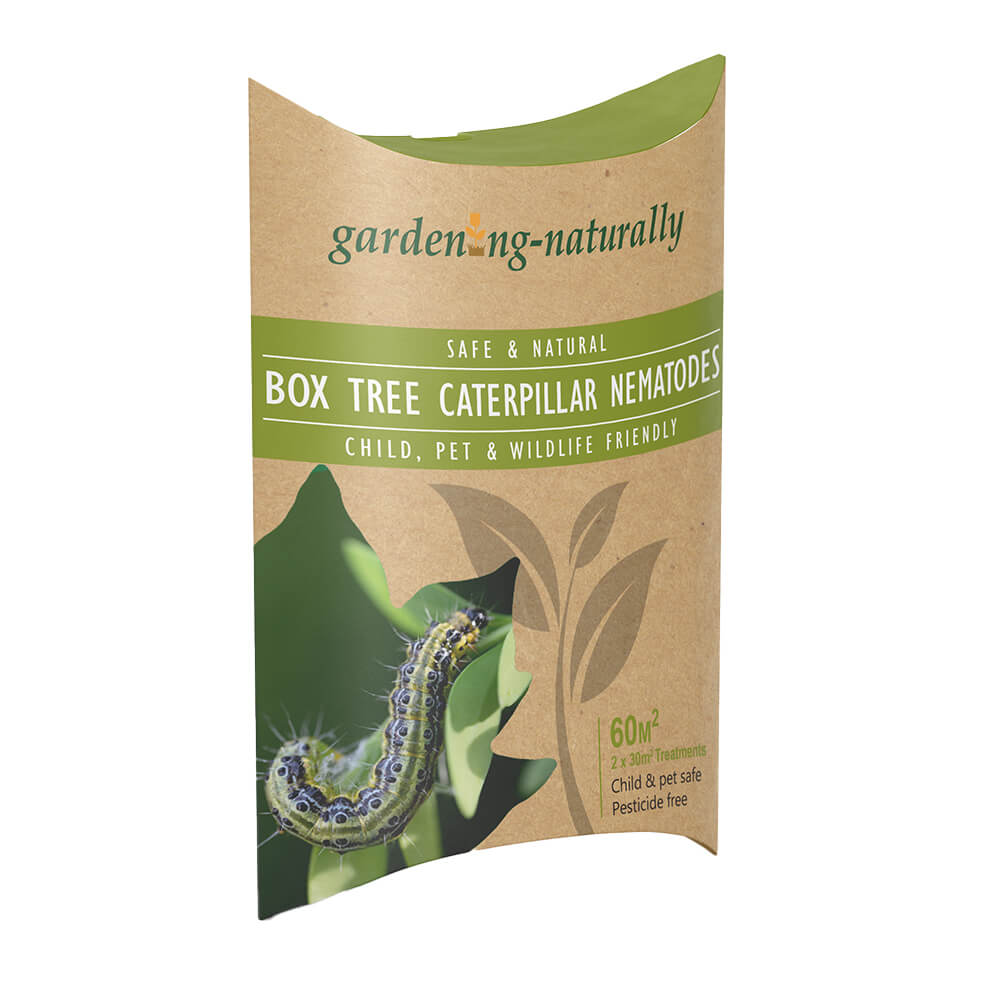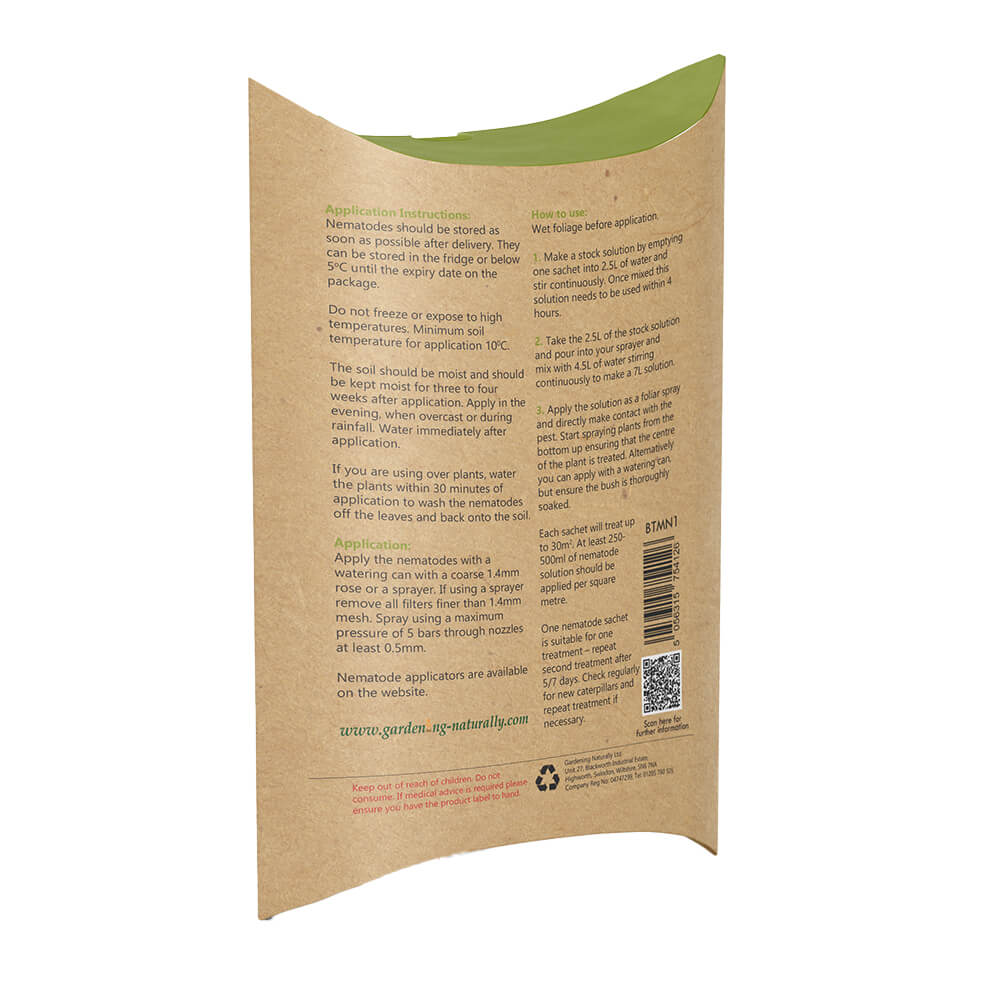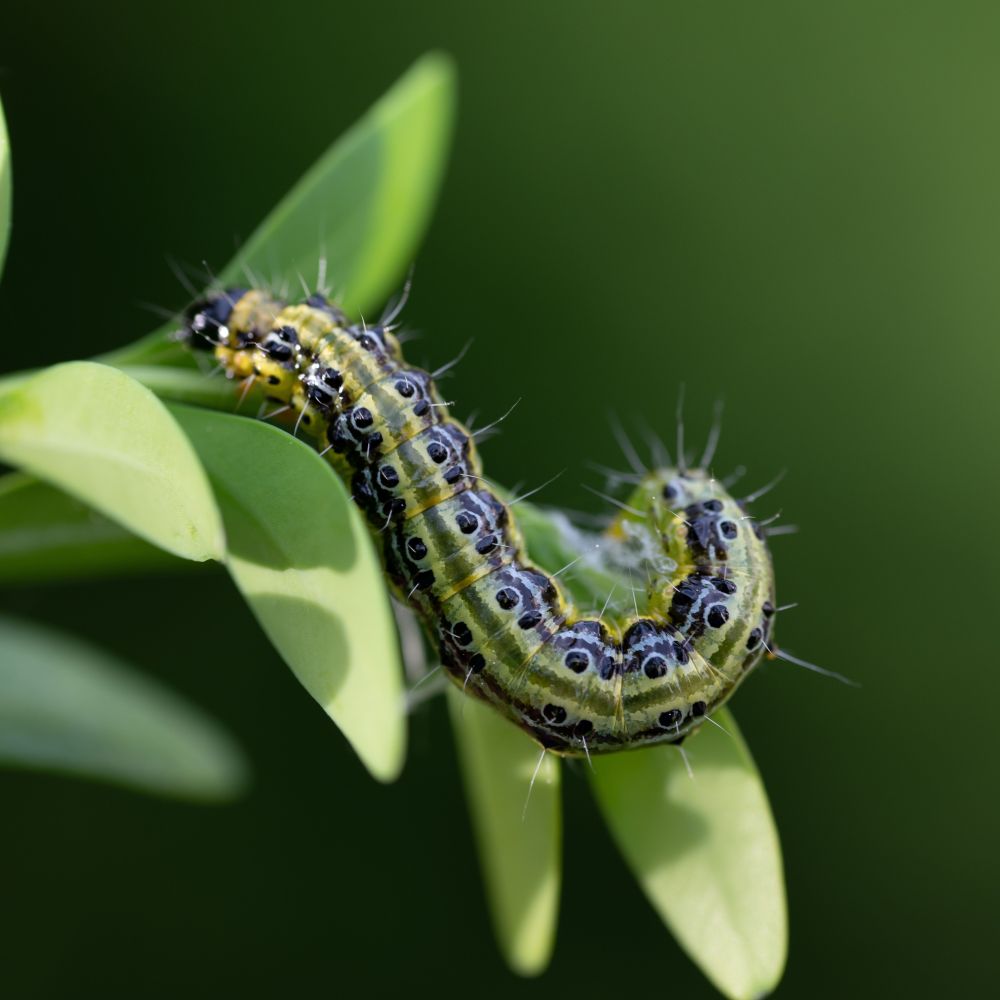Box Tree Moth Caterpillar Nematodes
Box Tree Moth Caterpillar Nematodes is backordered and will ship as soon as it is back in stock.
Box Tree Moth Caterpillar Problem in Box Hedges
Box moth caterpillars can cause significant damage to box hedges in a short amount of time. These pests feed on the leaves of box plants, leaving unsightly bare patches and, if left unchecked, can even kill the plant.
How to Identify Box Tree Caterpillars
Box moth caterpillars are the larvae of the box tree moth. These caterpillars hatch from eggs laid on the undersides of leaves and feed voraciously, stripping the plant of its foliage. The presence of webbing on the plant, along with chewed leaves, is a clear sign of an infestation. Easy to identify, they hatch as green and yellow caterpillars with a black head. As they mature, they develop black and white stripes on their bodies.
Natural Control with Box Moth Nematodes
Box moth nematodes, Steinernema mix (feltiae/carpocapsae), offer a natural way to kill the caterpillars. These microscopic worms actively seek out and parasitise the caterpillars, stopping them from feeding and causing further damage.
Pet-Friendly Pest Control
Box moth nematodes are easy to apply and safe to use around children, pets, and wildlife. They do not harm beneficial insects such as bees, butterflies, or ladybirds.
When to Apply Box Moth Nematodes
The nematodes should be applied when the caterpillars are most active, between March and October. These nematodes treat 30 m² twice. You will receive two packs; the second pack should be used 5–7 days after the first pack.
Box Tree Caterpillar Treatment Tips
Check the plants on a regular basis and treat again if necessary. If you need more help than just nematodes, check out our box moth traps. We stock a range of products to make applying nematodes easy.
If you need more help than just nematodes check out our box moth traps.
We stock a range of products to make applying nematodes easy.
Frequently Asked Questions on Box Moth Nematodes
What are box moth nematodes and how do they control caterpillars?
Box moth nematodes are a mix of Steinernema feltiae and Steinernema carpocapsae, two beneficial microscopic worms that actively seek out and infect box moth caterpillars, stopping them from feeding and reducing damage to box hedges.
How do I know if I have a box tree caterpillar infestation?
Look for green and yellow caterpillars with black heads, later developing black and white stripes. Signs include chewed leaves, defoliation, and webbing on the plant. These symptoms indicate an active box tree moth caterpillar infestation.
Are box moth nematodes safe for children, pets, and beneficial insects?
Yes, they are completely safe for use around children, pets, and wildlife. They do not harm pollinators like bees, butterflies, or beneficial insects such as ladybirds.
When is the best time to apply box moth nematodes?
Apply box moth nematodes when caterpillars are active — typically between March and October. This is when they are most vulnerable and easier to target.
How do I apply box moth nematodes to my plants?
Mix the nematodes with water and apply using a watering can, garden sprayer, or nematode applicator. Make sure the foliage is moist and apply in the evening or on cloudy days to avoid UV exposure.
How often should I use box moth nematodes for effective control?
You will receive two treatments. Apply the second pack 5–7 days after the first to ensure thorough control. Check your plants regularly and retreat if necessary.
How much area does one pack of box moth nematodes cover?
Each purchase includes two packs that together treat up to 30 square metres (m²) twice — ideal for large or multiple box hedges.
Can box moth nematodes kill all stages of the caterpillar?
They are most effective on actively feeding caterpillars. Apply when you first notice caterpillar activity for best results. Eggs and pupae are not affected.
Will box moth nematodes damage my box plants?
No, box moth nematodes are completely plant-safe. They target only the caterpillars and do not harm the plants themselves.
Can I store nematodes before using them?
Yes, keep the nematodes refrigerated until use to maintain their viability. Do not freeze them or store them in direct sunlight.
Do I need any special equipment to apply nematodes?
No special equipment is required, but using a nematode applicator or a fine rose watering can will ensure even and effective distribution or alternatively, a watering can rose head can also be used with a standard watering can.
What if I need additional help controlling box tree moths?
For extra control, consider using our box moth traps alongside nematodes. These traps help monitor and reduce adult moth populations.
Reviews
Reviews
How To Use
How To Use
Wet foliage before application. 1. Make a stock solution by emptying one sachet into 2.5L of water and stir continuously. Once mixed this solution needs to be used within 4 hours. 2. Take 2.5L of the stock solution and pour into your sprayer and mix with 4.5L of water stirring continuously to make a 7L solution. 3. Apply the solution as a foliar spray and directly make contact with the pest. Start spraying plants from the bottom up ensuring that the centre of the plant is treated. Alternatively, you can apply with a watering can, but ensure the bush is thoroughly soaked. Each sachet will treat up to 30m2. At least 250- 500ml of nematode solution should be applied per square metre. One nematode sachet is suitable for one treatment – repeat second treatment after 5/7 days. Check regularly for new caterpillars and repeat treatment if necessary.







